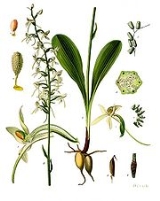
Platanthera bifolia
Encyclopedia
Platanthera bifolia, commonly known as the Lesser Butterfly-orchid, is a species of orchid in the genus Platanthera
, having certain relations with the genus Orchis
, where it was previously included and also with the genus Habenaria
. It can be found throughout Europe and Morocco. The name Platanthera is derived from Greek, meaning "broad anthers", while the species name, bifolia, means "two leaves".
in South Uist
(1949) and with the Common Spotted-orchid and the Heath Spotted-orchid.
), in hill pastures up to 400m, on heaths and moorland, and in tussocky marshy ground.
, Small Elephant and, to a lesser extent, Elephant Hawk-moths.
Platanthera
The genus Platanthera belongs to the subfamily Orchidoideae of the family Orchidaceae, and comprises about 100 species of orchids. The members of this genus were previously included in the genus Orchis, which is a close relative . They are distributed throughout the temperate regions of the...
, having certain relations with the genus Orchis
Orchis
Orchis is a genus in the orchid family . This genus gets its name from the Ancient Greek ὄρχις orchis, meaning "testicle", from the appearance of the paired subterranean tuberoids....
, where it was previously included and also with the genus Habenaria
Habenaria
Habenaria, commonly called bog orchids, are a far ranging genus of orchid, one of approximately 800 described Orchidaceae genera within that large and diverse family. There are species in both tropical and temperate zones.-Description:...
. It can be found throughout Europe and Morocco. The name Platanthera is derived from Greek, meaning "broad anthers", while the species name, bifolia, means "two leaves".
Identification
Lesser Butterfly-orchids are not to be confused with the Greater Butterfly-orchid, which are about the same size. Lesser Butterfly-orchids are distinguished by their two shining green basal leaves, especially of the hill form, which are shorter and broader. There are usually around 25 white flowers tinged with yellow-green in a slim flower spike. The upper sepal and petals form a loose triangular hood above the pollinia, which lie parallel and close together, obscuring the opening into the spur, which is long and almost straight. The flowers are night-scented, but the chemical components of the scent are different to those of Greater Butterfly-orchid and attract different pollinators.Hybrids
Hybrids of the two butterfly-orchids are rare, as are those between Lesser Butterfly-orchid and other species. However, hybrids have been recorded with Frog OrchidFrog Orchid
The Frog Orchid, or Coeloglossum viride, also known as the Long-Bracted Green Orchid and Dactylorhiza viridis is a monotypic genus of the family Orchidaceae generally found within the palearctic ecozone throughout the mid to northern United States through Canada, and in the British Isles and parts...
in South Uist
South Uist
South Uist is an island of the Outer Hebrides in Scotland. In the 2001 census it had a usually resident population of 1,818. There is a nature reserve and a number of sites of archaeological interest, including the only location in Great Britain where prehistoric mummies have been found. The...
(1949) and with the Common Spotted-orchid and the Heath Spotted-orchid.
Habitat
The Lesser Butterfly-orchid occupies a wide range of habitats, being far more tolerant of acid conditions than the Greater Butterfly-orchid. They are found in grasslands, woodlands (especially Beech woods in southern EnglandSouthern England
Southern England, the South and the South of England are imprecise terms used to refer to the southern counties of England bordering the English Midlands. It has a number of different interpretations of its geographic extents. The South is considered by many to be a cultural region with a distinct...
), in hill pastures up to 400m, on heaths and moorland, and in tussocky marshy ground.
Pollination
Sphingid moths are attracted by the scent of this orchid, and tend to hover in front of the flowers, resting their forelegs on the lip. As the proboscis enters the spur it pushes between the pollinia, dislodging the sticky discs which adhere to it. Pollinators include PinePine
Pines are trees in the genus Pinus ,in the family Pinaceae. They make up the monotypic subfamily Pinoideae. There are about 115 species of pine, although different authorities accept between 105 and 125 species.-Etymology:...
, Small Elephant and, to a lesser extent, Elephant Hawk-moths.

